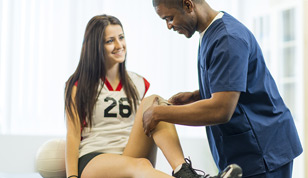Blog Categories
Search Blog
Blog Categories
Preventing ACL Injuries
In my physiotherapy practice at Boomerang Health, I see a lot of active adolescents and children. As a result, I also see a lot of ACL injuries; and parents frequently ask if this injury could have been prevented.
ACL stands for anterior cruciate ligament and it is one of the major ligaments in your knee. ACL injuries most commonly occur during sports that involve sudden stops and changes in direction, such as basketball, soccer, football and volleyball.
The bulk of the ACL injuries I see are in teens, 15 to 17 years old, although, I have seen injuries in children as young as 12. This injury is more common in female athletes and is very common in soccer players. There are risk factors related to the young athletes that may predispose them to sustaining an ACL injury.
Growth spurts can also be a contributing factor. Some young athletes grow as much as two inches in two months. When this occurs, their centre of gravity changes and coordination can be affected. Athletes need time to get used to their growing body and training should accommodate the changes in bone length. Skills that were mastered previously may need to be relearned with their new height and weight. So it is important to keep adjusting their training when parents and coaches see a change in growth.
To prevent ACL injuries, consider the following areas: overall strength, flexibility and muscle control. Lower extremity strength includes the quadriceps, hamstrings and the gluteal muscular group. It is important to strengthen the muscles in a manner that is sports specific. For example, if an athlete measures their level of strength on a leg extension machine to see how much weight they can extend, this may not necessarily translate into dynamic (or active) muscle control needed during the sporting activity. This means we have to strengthen the lower extremity and core to include squats, stop/starts and agility movement patterns that would be found in the sport. It is also important to note that these specific skills must be applied to athletes that already have a significant degree of strength and flexibility.
An important message to parents and coaches is to watch for height and weight changes in active children in order to prevent injuries. Be aware that an athlete may need to modify and/or relearn a specific sporting skill as growth changes occur. This could help prevent ACL injuries and keep your athlete active and injury free.
To learn more about preventing injuries through strength training and exercises, contact the physiotherapy department at Boomerang Health.






